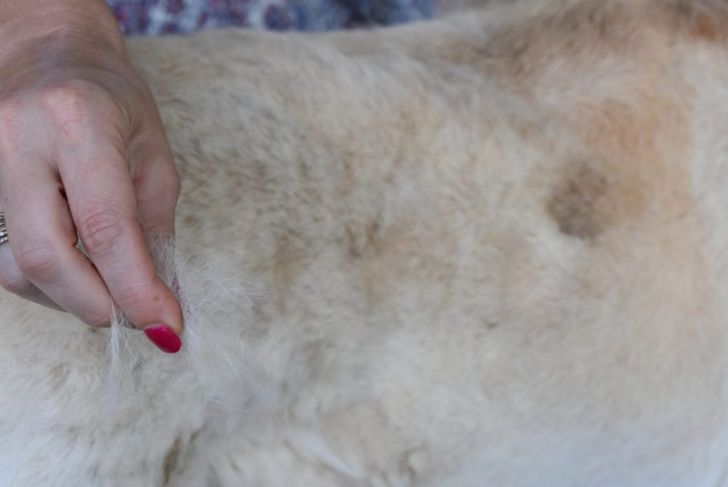Like humans, older dogs experience changes and conditions due to their age. Cushing’s disease, also known as hyperadrenocorticism (HAC), strikes middle-aged or older dogs over the age of six. It can also appear in horses and cats but is much less common. Veterinarians diagnose around 100,000 dogs each year with Cushing’s disease. Medical treatments are available, but an accurate diagnosis is essential to providing the best care for the dog. Symptoms don’t usually appear overnight. Like natural aging, the signs of Cushing’s disease appear gradually, and owners may not notice them until more serious symptoms start to occur.
What is Cushing’s Disease?
Cushing’s disease causes the body to produce too much cortisol, a hormone that the adrenal glands produce and store. Normally, cortisol helps dogs adapt to stress and plays a role in the “fight or flight” response. It regulates skin health, body weight, and tissue structure. An overabundance of cortisol weakens the dog’s immune system. Cushing’s disease mimics other diseases, so the symptoms may not be as noticeable in the early stages.
The Three Types of Cushing’s Disease
Over 80% of the dogs diagnosed with Cushing’s have developed a tumor on the pituitary gland, located at the base of their brains. Pituitary-dependent hyperadrenocorticism (PDH) is usually benign. A smaller number of dogs, about 15%, develop a tumor on the adrenal glands just in front of the kidneys. Adrenal tumor hypercortisolism produces tumors. Research shows that about half of these tumors are malignant, while the other half are benign. Vets describe the third type as iatrogenic Cushing’s disease. If a dog receives long-term, cortisol-like steroids as a treatment for a legitimate medical condition, they are at a higher risk of developing the disease. Steroids can lead to an excess of cortisol and cause the same symptoms as the naturally occurring Cushing’s disease.
Breeds More Commonly Diagnosed
Larger breeds are more prone to adrenal tumor hypercortisolism. Female dogs are three times more likely than male dogs to develop adrenal-type Cushing’s disease. Most research indicates that veterinarians diagnose PDH in higher numbers in specific breeds, including dachshunds, terriers, and poodles. Some vets say that there is a higher prevalence of PDH in beagles, boxers, German shepherds, Labrador retrievers, American Eskimo dogs, Australian shepherds, Maltese, and cocker spaniels.
Early Signs and Symptoms of Cushing’s Disease
Because the signs mimic aging, the early symptoms often go unnoticed. Most dogs with Cushing’s disease experience a significant increase in appetite. This is because cortisol stimulates the appetite. Owners also notice an increase in their dog’s water consumption. Their pet may also pant more than usual. Lethargy is another early symptom. The dog isn’t as active as usual. They may seem drowsy or have no interest in playing, going for walks, or other normal activities. Owners will likely notice that their dog is urinating more often. Their pet may start accidentally urinating indoors.
Other Symptoms of the Disease
Cushing’s is a progressive, chronic disease. As it progresses, the owner notices hair loss on their dog’s back and body, but not on the head and legs. Some owners observe that their dog’s hair doesn’t grow back as quickly between groomings or clippings. Increased muscle weakness leads to the dog’s inability to perform activities they didn’t have trouble with before. This includes climbing stairs or jumping into a car. Their skin may thin out, which makes them more prone to skin infections. But one of the most prominent symptoms is an enlarged abdomen. Dogs with Cushing’s have a pot-bellied appearance.
Diagnosis
Because the symptoms mimic other conditions, a veterinarian will first consult with the owner and discuss the symptoms. After examining the dog, the vet will determine whether or not the symptoms indicate Cushing’s disease. They will then perform basic blood and urine tests. Dogs that have the condition usually exhibit high blood pressure, urinary tract infections, dilute urine, and increases in blood cholesterol. If the urine and blood tests confirm the initial diagnosis, the vet may perform additional tests to determine the type of Cushman’s disease. These include:
- ACTH stimulation blood tests
- Low-dose dexamethasone suppression (LDDS) blood test
- Chest X-rays
- CT scan
- MRI
- Abdominal ultrasound
- Hair analysis
Treatment for PDH
If the testing confirms a pituitary tumor, the veterinarian may suggest removing the tumor surgically. However, this type of treatment is still under development and not widely available. Radiation is another option. Most vets prescribe medications instead. Some of these medications block cortisol production. Other types of medications kill cortisol-producing cells. Administering the proper amount of prescribed medication is essential. Under-dosing can lead to continued symptoms and complications. If the dosage is too high, it may cause the dog to become seriously ill or lead to additional symptoms.
Treatment for Adrenal-type Cushing’s Disease
Veterinarians usually treat adrenal tumors surgically. The vet may remove the tumor. However, some vets use a minimally invasive procedure using a fiberoptic instrument called a laparoscope. Leading up to the surgery, the vet may prescribe additional medical treatments. Following the surgery, the vet usually prescribes cortisone replacement therapy. This can last for a few weeks to several months. If the tumor is malignant and the malignancy has spread to other areas, the vet will likely not recommend surgery. Instead, they will prescribe medical treatments to control the dog’s symptoms.
Prognosis
Most dogs respond well to treatment. Medications usually keep Cushing’s tumors in check. If the tumor is malignant, however, the prognosis is poor. Dogs with pituitary-type Cushing’s usually survive an additional 2 years. Without treatment, the dog will continue to have problems that may get worse. They will eat more, drink more water, and experience increased urination. Uncontrolled Cushing’s disease leads to weakness, high blood pressure, diabetes, lung and respiratory disease, fragile skin that is prone to infections, recurring urinary tract infections, pancreatitis, and protein loss.
To Treat or Not To Treat
Cushing’s disease itself does not cause death. Because it occurs in older dogs, the causes of death are usually unrelated to the disease. However, if an owner feels their pet is doing well and doesn’t see any outward abnormalities, vets may not recommend treatment. Most vets determine treatments based on whether or not they will improve the dog’s quality of life. They also prescribe treatment for those dogs at a higher risk of developing complications of the disease. Owners who want to ensure their pet’s comfort usually opt for treatment if the cost justifies the expense. However, life span prognosis is generally the same, with or without treatment.

 Home
Home Health
Health Diet & Nutrition
Diet & Nutrition Living Well
Living Well More
More




















